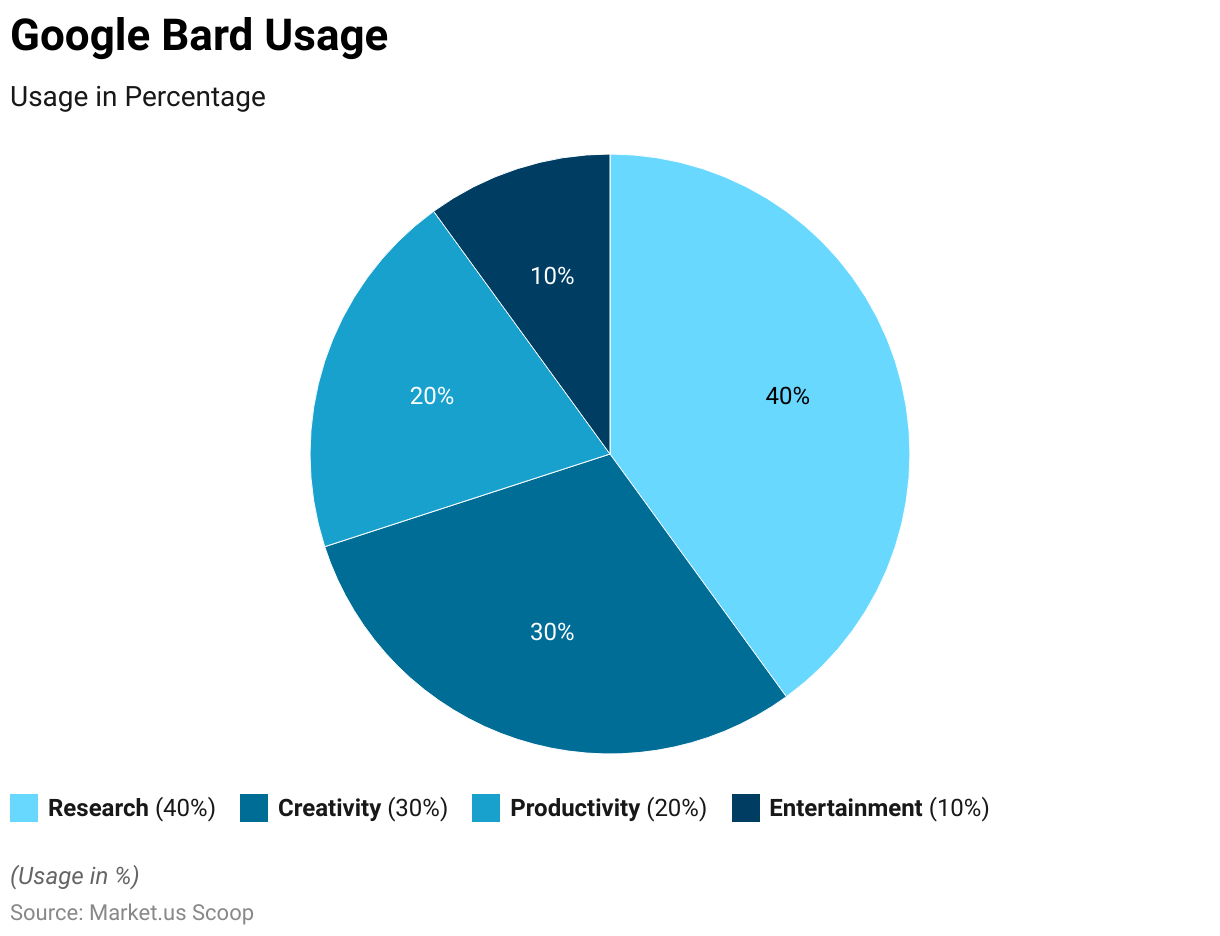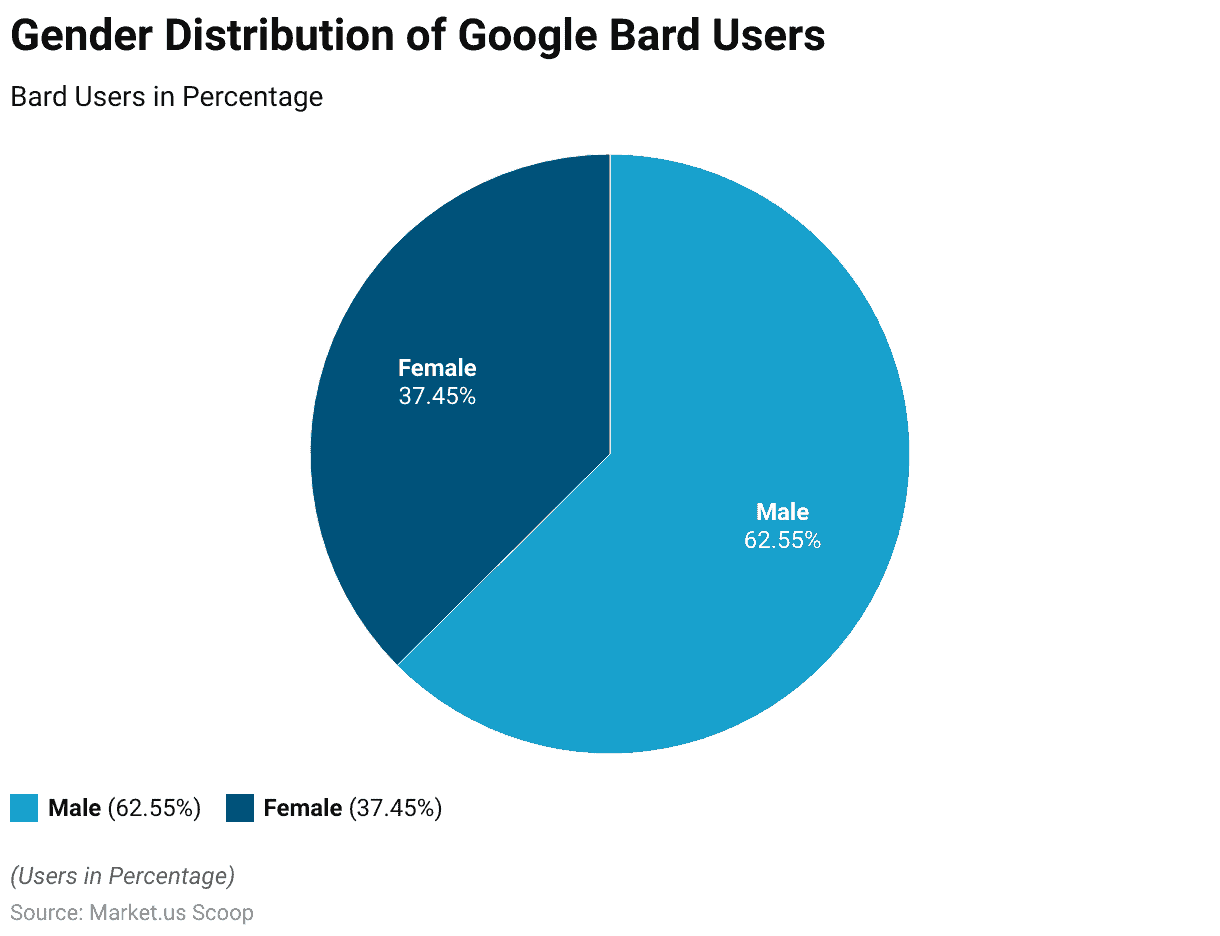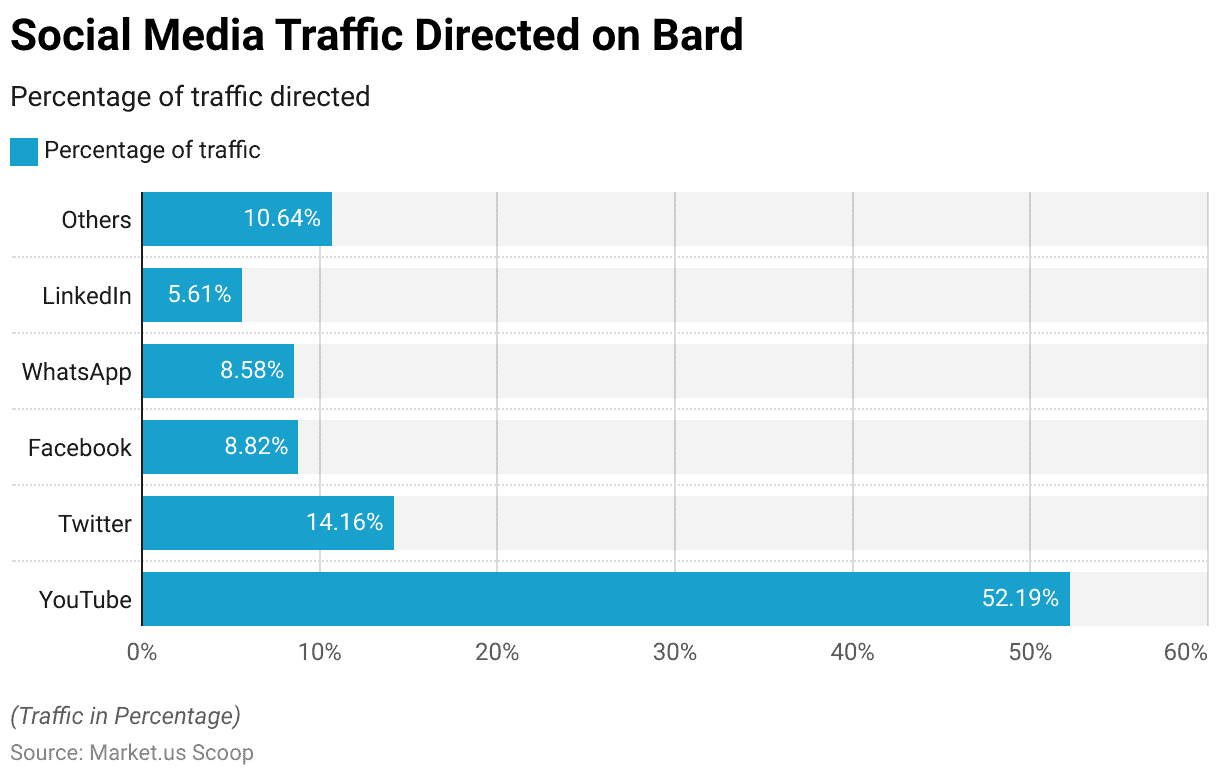Table of Contents
- Introduction
- Editor’s Choice
- Overview of Google Bard
- Timeline of Google Bard
- Google Bard User Statistics
- Google Bard Visits
- Bard Audience Demographics
- Regional Variations in Usage
- Google Bard Marketing Channels
- Engagement of Social Media Platforms
- Training Dataset of Google Bard
- Referral Traffic to Google Bard
- Outgoing Links from bard.google.com
- Estimated Costs
- Google Bard vs. ChatGPT
Introduction
According to Bard Statistics, Google Bard is a chatbot developed by Google to facilitate natural conversations through cutting-edge technology like natural language processing and machine learning. It goes beyond enhancing Google search by seamlessly integrating into websites, messaging apps, or applications, delivering responses that mimic human interaction.
Bard aims to improve the search experience by enabling users to ask questions in everyday language, eliminating the need for specific keywords. It’s trained on real conversations, ensuring its responses are relatable and natural, with added context for more meaningful information. One standout feature is its ability to handle follow-up questions, a unique aspect of search tools.
Editor’s Choice
- Natural Language Processing Market size is expected to be worth around USD 453.3 Billion by 2032
- Google Bard is on track to surpass one billion users by the end of 2023, with over 140.6 million monthly visitors.
- People from more than 230 countries and territories have access to this chatbot.
- Bard is available in over 43 languages, including Chinese, Korean, Arabic, Hindi, and Spanish.
- Demographically, 60% of Bard’s users are male, and 40% are female.
- The largest user group, comprising 34.20%, falls in the 25 to 34 age range, followed closely by the 18 to 24 age group.
- In terms of global traffic, the United States leads with 37.24%, followed by India.
- It’s estimated that each search query on Bard costs between $0.006 and $0.031 to run.
- Regarding traffic sources, more than 76% come directly, while 16.77% are organic.

Overview of Google Bard
- Google Bard was officially launched on March 21, 2023, following its foundation on February 8, 2023, under the umbrella of its parent company, Google, a subsidiary of Alphabet Inc.
- With a substantial user base, Bard attracts around 140.6 million monthly visitors across 230 countries and territories.
- It boasts language support in 43 languages, underpinned by the powerful LaMDA.
- The extensive training dataset powering Bard encompasses a staggering 750 GB of data, equivalent to 1.56 trillion words.
- Notably, the cost per query for this sophisticated AI chatbot ranges from $0.003 to $0.028, reflecting its resource-intensive capabilities.
Timeline of Google Bard
- Google Bard’s journey has seen a series of significant updates and enhancements since its launch on February 6, 2023.
- Access opened to the public on March 21, welcoming a broader user base. Subsequent updates in April included adding an experiment updates page and introducing the ‘Google it’ option, enhancing user convenience.
- The evolution continued in April with Bard’s expanded support for 20 programming languages and the introduction of various drafts on April 21.
- June 2023 ushered in improvements, making Bard’s responses location-relevant and enabling coding assistance, particularly in math and data analysis. Users could also export Bard tables to Google Sheets, enhancing data management capabilities.
- July marked a significant expansion, as Bard became available in 40 additional languages and 27 more countries, broadening its global reach.
Google Bard User Statistics
- Google Bard is anticipated to reach a user base of over 1 billion, although specific user figures are currently unavailable.
- This projection is bolstered by the robust monthly traffic, exceeding 140.6 million visitors.
- Regarding user purposes, 40% utilize Google Bard to research topics of interest, while 30% employ the chatbot for creative endeavors such as crafting poems, scripts, and stories.
- Additionally, 20% seek assistance with work or educational tasks, leaving the remaining 10% to use Bard for entertainment purposes like gaming, video searches, and music exploration.

Google Bard Visits
- In the summer months of June, July, and August 2023, two distinct platforms, bard.google.com and bardai.io, witnessed varying levels of visitor traffic.
- Bard.google.com, the largest of the two, experienced substantial user engagement with 140.6 million visits in June, which increased to 189.2 million in July and remained strong at 183.5 million in August.
- In contrast, bardai.io, a more specialized platform, saw comparatively lower visitor numbers.
- It recorded 160.7 thousand visits in June, 104.5 thousand in July, and 96.3 thousand in August. These statistics highlight the fluctuations in user activity across these platforms during the specified summer months.
- The top keyword, simply “bard,” garners significant attention with 2.4 million searches, indicating a strong user interest.
Bard Audience Demographics
Age-wise Distribution of Bard
- The usage of Bard across different age groups varies significantly. The highest user percentage falls within the 25-34 age bracket, accounting for 34.20% of Bard’s user base.
- The 18-24 age group follows closely behind, representing 22.21% of users.
- Users aged 35-44 comprise 19.68% of Bard’s users, while the 45-54 age group constitutes 12.86% of the user base.
- In the older age demographics, Bard sees progressively fewer users, with 7.03% in the 55-64 age group and 4.02% among users aged 65 and above.
Gender Distribution of Bard Users
- Bard’s user base displays a noticeable gender distribution, with 62.55% male users, while female users account for 37.45%.
- This gender split sheds light on the demographic composition of Bard’s users, with a higher prevalence of male engagement than female users.
Regional Variations in Usage
- Google Bard draws its traffic from a global audience, with a predominant share originating from the United States, contributing to 37.24% of the total traffic.
- India follows as the second-largest source of traffic, accounting for 9.56%.
- Japan and the United Kingdom also play substantial roles, with 6.67% and 5.44% of the traffic, respectively.
- Australia adds to the international presence, providing 2.53% of the traffic.
- The remaining 38.56% of the traffic comprises visitors from various other countries, showcasing the diverse and widespread user base on a global scale.

Google Bard Marketing Channels
- Google Bard’s traffic sources are diversified across various marketing channels. The largest share of traffic, amounting to 79.61%, comes directly, indicating that many users access Bard without intermediaries.
- Referrals contribute a smaller yet notable 2.45% of the traffic, suggesting that some users discover Bard through external websites or sources.
- Organic search constitutes 13.84% of the traffic, highlighting the significance of users finding Bard through search engines without paid promotions.
- Paid search and social media channels contribute a modest portion, with 1.98% and 1.9%, respectively, indicating some level of paid advertising and social media engagement.
- Email marketing and display ads represent a smaller fraction, with 0.18% and 0.04% of the traffic, respectively.
Engagement of Social Media Platforms
- Google Bard receives traffic from various social media platforms, with YouTube being the most significant source, contributing 52.19% of the total traffic.
- Twitter is the second-largest contributor, directing 14.16% of users to Bard.
- Facebook and WhatsApp also play substantial roles, accounting for 8.82% and 8.58% of the traffic, respectively.
- LinkedIn adds to the mix, with 5.61% of the traffic from this professional network.
- Other social media platforms collectively contribute 10.64% of the traffic, showcasing the diverse sources through which users discover and engage.

Training Dataset of Google Bard
- Google Bard’s training dataset comprises diverse sources, each contributing a distinct percentage. Most of the dataset, 50%, is derived from dialog data sourced from forums, reflecting real-world conversational interactions.
- A substantial portion, 12.5%, is based on C-4 data, likely to provide a wide range of textual content for training.
- The inclusion of English Wikipedia data, also at 12.5%, underscores the significance of this reputable knowledge source.
- Code documents contribute 12.5%, focusing on technical and programming-related content.
- The dataset also encompasses 6.3% of English and non-English web documents, balancing language-specific and multilingual content sources.
Referral Traffic to Google Bard
- Referral traffic to bard.google.com is diverse, originating from various categories. Notably, a significant portion, 33.61%, comes from Search Engines, indicating that users often discover bard.google.com through web searches.
- The Computers, Electronics, and Technology category also contributes substantially, with 26.33% of the referral traffic, showcasing the relevance of bard.google.com to tech-related content.
- Email referrals account for 16.07%, indicating that email communications also play a role in directing users to the platform.
- The programming and developer software category contributes 12.4% of the traffic, underscoring the technical nature of some content hosted on bard.google.com.
- Additionally, a small fraction, 1.99%, stems from File Sharing and Hosting, while 9.6% falls into the ‘Other’ category, representing a mix of miscellaneous sources that bring traffic to bard.google.com.
Outgoing Links from bard.google.com
- Bard.google.com features a range of outgoing links across different categories, reflecting its engagement with various online resources. A significant proportion of these outgoing links, at 49.11%, belong to the Programming and Developer Software category, highlighting the platform’s relevance to technical content.
- The Computers, Electronics, and Technology categories contribute notably, accounting for 31.06% of the outgoing links, underscoring its connection to tech-related resources.
- Search Engines also play a role, contributing 8.31% of the links, suggesting connections to external search results or tools.
- Email-related links constitute 7.53%, reflecting interactions with email services.

Estimated Costs
- Each search on Google Bard incurs a base cost of $0.003 per inquiry, along with an extra charge ranging from $0.003 to $0.028, added to the standard search cost.
- Consequently, the total expense for each Bard search can fall between $0.006 to $0.031.
- Google Bard’s responses, generated with different word counts, correlate with the percentage of Google queries handled by AI. For instance, when 25 words are generated per query, with AI handling 10% of Google queries, it amounts to an estimated cost of $0.6 billion.
- This pattern continues with 75 words generated per query and 100 words generated per query, with the estimated costs doubling and tripling accordingly.
- For instance, when AI handles 30% of Google queries and generates 75 words per response, the projected cost is $5.4 billion.
Google Bard vs. ChatGPT
- User engagement differs between the two, with Google Bard recording an average session duration of 3.19 minutes, while ChatGPT boasts a longer average session duration of 8.44 minutes.
- Additionally, their pre-training data cut-off points vary, with Google Bard’s data cut-off in 2019, while ChatGPT’s data extends up to 2021.
- Cost-wise, the incremental expense per query ranges from $0.003 to $0.028 for Google Bard, while ChatGPT has a more fixed cost of $0.0036 per query.
- Regarding subscription models, Google Bard currently offers its services for free. In contrast, ChatGPT provides both a free tier and a subscription-based Plus plan at $20 per month, offering additional features and benefits to users.
- Finally, when it comes to data storage size, ChatGPT requires 570 GB, whereas Google Bard demands a slightly larger storage capacity of 750 GB.
Discuss your needs with our analyst
Please share your requirements with more details so our analyst can check if they can solve your problem(s)



